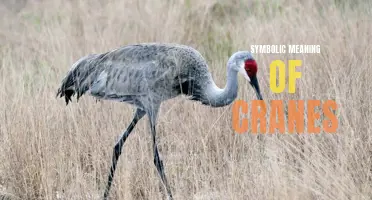
October is a month filled with vibrant colors, crisp air, and a sense of change in the atmosphere. It is a time when the world around us transforms, painting landscapes in shades of red, orange, and gold. Beyond the beauty of nature's spectacle, October is also rich in symbols and meanings. From pumpkins and owls to bats and black cats, these icons evoke a sense of mystery, magic, and folklore. They beckon us to deeper reflections on the cycle of life, the thinning of the veil between worlds, and the power of embracing darkness as a pathway to enlightenment. So let us dive into the realm of October symbols and discover the hidden truths they hold.
What You'll Learn
- What are some common symbols associated with the month of October?
- Are there any specific symbols or meanings associated with Halloween in October?
- How do these symbols and meanings tie into the overall theme of autumn?
- Are there any cultural or historical references that contribute to the symbols and meanings of October?
- How have these symbols and meanings evolved or changed over time?

What are some common symbols associated with the month of October?
October is a month known for its autumnal beauty and its associations with Halloween. As such, there are several common symbols that are associated with the month of October. These symbols represent the changing season, the spooky holiday, and the transition from summer to winter.
One of the most recognizable symbols of October is the pumpkin. These orange fruits are closely associated with Halloween and are often carved into jack-o'-lanterns. Pumpkins are also used as decorations during the fall season and are a popular ingredient in various recipes, such as pumpkin pie. The pumpkin is a symbol of abundance and harvest, and its vibrant color represents the changing leaves of autumn.
Another common symbol of October is the autumn leaf. As the trees begin to change colors and shed their leaves, the vibrant hues of red, orange, and yellow create a stunning display. These colorful leaves are often associated with the beauty of the fall season and are used in various seasonal decorations. They can also symbolize the cycle of life and the changing of the seasons.
Black cats are another symbol often associated with the month of October. These sleek and mysterious felines have long been associated with Halloween and are often seen as symbols of good luck or bad luck depending on cultural beliefs. In some cultures, they are believed to bring good luck, while in others, they are associated with witchcraft and are considered omens of bad luck.
Witches and broomsticks are also common symbols associated with October. These symbols are usually associated with Halloween and the folklore surrounding it. Witches are often portrayed as magical and enchanting figures, and their broomsticks are seen as a means of transportation. These symbols are often seen in Halloween decorations and costumes.
Lastly, the full moon is a symbol often associated with October. This is because the full moon in October is known as the Harvest Moon, which traditionally marked the time for farmers to gather their crops. The Harvest Moon is believed to provide extra light during the night, making it easier for farmers to work late into the evening. The full moon is also associated with werewolves and other mythical creatures, adding to its mystique and association with Halloween.
In conclusion, October is a month filled with symbolism. From pumpkins and autumn leaves to black cats and witches, these symbols represent the changing season and the spooky holiday of Halloween. They add to the overall atmosphere and charm of the month and are a fun way to celebrate all that October has to offer.
The Deep Symbolism of Sacrifice in Berserk: Unraveling Its Meaning
You may want to see also

Are there any specific symbols or meanings associated with Halloween in October?
Halloween in October is a holiday that is celebrated in many countries around the world. It is often associated with spooky costumes, haunted houses, and of course, candy. But did you know that there are also specific symbols and meanings associated with Halloween?
One of the most well-known symbols of Halloween is the jack-o'-lantern. This is a carved pumpkin with a candle or light inside. The tradition of carving pumpkins dates back to ancient Celtic cultures, where they would carve faces into turnips to ward off evil spirits. When the tradition came to America, pumpkins were readily available and became the preferred vegetable for carving. The jack-o'-lantern is seen as a symbol of protection and often placed outside homes to ward off evil spirits.
Another popular symbol of Halloween is the black cat. These feline creatures have long been associated with witches and magic. In folklore, it was believed that witches could turn into black cats, and if one crossed your path, it was considered bad luck. However, in many cultures, black cats are also seen as symbols of good luck and prosperity. During Halloween, you will often see black cat decorations, as they are believed to bring good fortune and protect against evil spirits.
Ghosts and skeletons are also common symbols of Halloween. These images are often associated with death and the afterlife. Halloween is believed to be a time when the barrier between the spirit world and the physical world is thinnest, allowing for communication with the dead. Ghosts are often depicted as white, transparent figures, while skeletons represent the physical remains of the deceased.
Spiders and spiderwebs are another symbol of Halloween. These creepy crawlers have long been associated with witches and dark magic. In medieval times, spiders were believed to be agents of evil and were associated with the dark arts. Spiderwebs are often used as decoration during Halloween, and it is believed that they can trap evil spirits and protect the home from harm.
Finally, the colors orange and black are strongly associated with Halloween. Orange represents the autumn harvest and the changing leaves, while black is often associated with darkness and mystery. These colors can be seen in Halloween decorations, costumes, and candy.
In conclusion, Halloween in October is a holiday with many symbols and meanings associated with it. From the jack-o'-lantern to black cats and spiders, these images are often seen as protection against evil spirits and a way to connect with the spirit world. So, next time you see a carved pumpkin or a black cat during Halloween, you'll know the deeper symbolism behind these popular images.
Understanding Arabic Symbols and Their Meanings
You may want to see also

How do these symbols and meanings tie into the overall theme of autumn?
Autumn, with its vibrant colors and cool breeze, is a season that brings about a sense of change and transition. It is often associated with symbolic meanings that tie into the overall theme of this time of year. From leaves falling to harvest festivals, autumn is a rich source of symbolism that reflects the beauty and essence of this season.
One of the most prominent symbols of autumn is the falling leaves. As the temperature drops, leaves change their colors, turning vibrant shades of red, orange, and yellow. This phenomenon signifies the changing seasons and the cycle of life. It reminds us that everything in life is impermanent, and that change is inevitable. The falling leaves also represent the shedding of the old to make room for new growth and possibilities.
Another symbol closely associated with autumn is the harvest. During this time of year, farmers gather the fruits of their labor, reaping the rewards of their hard work. The harvest signifies abundance and gratitude, as it is a time to appreciatively celebrate the bountiful gifts of nature. It also serves as a reminder to pause and reflect on our own accomplishments and blessings.
Pumpkins and gourds are another set of symbols that are deeply connected to autumn. These vegetables are often associated with Halloween and Thanksgiving, two major holidays celebrated during this season. Pumpkins symbolize harvest, abundance, and fertility. They are commonly used for decoration during Halloween, carved into jack-o'-lanterns. The act of carving pumpkins is a creative and festive way to mark the arrival of autumn and to ward off evil spirits.
In addition to the natural aspects, certain animals are also symbolic of autumn. The most notable one is the squirrel, which is often depicted collecting and storing nuts for the winter months. This activity portrays a sense of preparation, as the squirrel is diligently getting ready for the colder days ahead. It symbolizes the importance of planning, foresight, and hard work in order to survive and thrive.
Overall, these symbols and their meanings tie into the overarching theme of autumn, which is change and transition. Autumn is a season of letting go of the old, embracing change, and preparing for the future. It encourages us to reflect, appreciate what we have, and make necessary adjustments in our lives. The symbolism of falling leaves, harvest, pumpkins, and animals like squirrels all contribute to this theme, reminding us of the beauty and significance of this transformative time of year.
The Symbolic Meanings Behind the Letter Y
You may want to see also

Are there any cultural or historical references that contribute to the symbols and meanings of October?
October is a month rich in cultural and historical references, which contribute to the symbols and meanings associated with this time of year. From ancient traditions to modern celebrations, October is a month filled with significance.
One of the most well-known cultural references in October is Halloween, which takes place on the last day of the month. Halloween has its roots in ancient Celtic traditions, specifically the festival of Samhain. It was believed that on the night of October 31st, the boundary between the living and the dead was blurred, and spirits could roam freely. To protect themselves from these spirits, people would wear costumes and masks and light bonfires. Over time, Halloween evolved into the holiday we know today, with traditions such as trick-or-treating, pumpkin carving, and haunted houses.
Another cultural reference in October is Oktoberfest, a festival celebrated in Munich, Germany. Oktoberfest is known for its beer, food, and festivities and attracts millions of visitors each year. The festival originated in 1810 to celebrate the wedding of Bavarian Crown Prince Ludwig and Princess Therese. Since then, it has become an important part of Bavarian culture and a symbol of German tradition.
October is also associated with harvest season in many parts of the world. In agrarian societies, October is a time of gathering crops and preparing for the winter months ahead. This connection to the harvest is seen in the symbols and decorations associated with this time of year, such as pumpkins, cornucopias, and colorful autumn leaves. These symbols serve as a reminder of the importance of nature's bounty and the cycle of life.
In addition to cultural references, October has historical significance as well. It is the birth month of several notable figures, including Mahatma Gandhi, Eleanor Roosevelt, and Pablo Picasso. These individuals have made a significant impact on the world through their work and serve as reminders of the power of human achievement and innovation.
Overall, the symbols and meanings associated with October are deeply rooted in cultural and historical references. From Halloween and Oktoberfest to harvest season and birthdays of influential figures, October is a month that holds great significance for many people around the world. Whether through celebrations, traditions, or personal reflections, October offers opportunities to connect with the past and embrace the present.
The Deep Symbolism of the Sicilian Three-Legged Structure: The Hidden Meanings Unveiled
You may want to see also

How have these symbols and meanings evolved or changed over time?
Throughout history, symbols have played a significant role in human communication. They have the power to convey complex ideas and emotions in a concise and easily understandable manner. However, the meanings associated with these symbols have not remained constant over time. They have evolved and changed, adapting to the cultural and societal shifts that shape human understanding.
One of the most iconic symbols that has evolved over time is the peace sign. Initially designed in 1958 to symbolize nuclear disarmament, it quickly gained popularity as a universal symbol for peace. Over the years, the peace sign has come to represent a broader range of meanings, including social justice, unity, and love. Its simplicity and versatility have allowed it to transcend its original purpose and become a symbol of hope and harmony.
Another symbol that has undergone significant changes over time is the swastika. In ancient times, the swastika was a sacred symbol in many cultures, representing good fortune and well-being. However, its association with Nazi Germany during World War II has forever changed its meaning. Today, the swastika is universally recognized as a symbol of hate and intolerance. Its transformation from a positive symbol to a negative one serves as a poignant reminder of the power symbols hold and their ability to shape our perception.
Religious symbols have also undergone shifts in meaning throughout history. The cross, for example, started as a symbol of suffering and crucifixion in Christianity. However, it has evolved to represent not only the sacrifice of Jesus but also hope, redemption, and eternal life. Similarly, the Star of David, originally a symbol of Jewish identity, has come to represent the Jewish faith as a whole. The meanings associated with these religious symbols have deepened and expanded over time, reflecting the spiritual journeys of believers throughout history.
In the realm of technology, symbols have also evolved significantly. The "@" symbol, originally used to signify "at the rate of," has now become synonymous with email addresses and online communication. The hashtag symbol, once simply a sign to denote numbers, has evolved to become a powerful tool in social media, used to create connections and promote trends. These symbols have successfully adapted to the digital age, taking on new meanings and reshaping human interaction in the process.
In conclusion, symbols and their meanings are not static. They have the ability to evolve and change over time, reflecting the cultural, societal, and technological shifts of the times. Whether it is the peace sign, the swastika, religious symbols, or technological symbols, their transformations carry important messages about our shared history and the power of collective understanding. As society continues to evolve, so too will the symbols that represent it, serving as a visual language that connects us all.
Decoding the Symbolism: Exploring the Meaning Behind Linkedin Symbols
You may want to see also
Frequently asked questions
The birthstone for October is the opal, which is known for its iridescent colors and unique play of light.
The birth flower for October is the marigold. Marigolds are often associated with warm autumn colors and are also believed to symbolize creativity and passion.
The astrological sign for October is Libra (September 23 - October 22) and Scorpio (October 23 - November 21). Libra is known for its social and diplomatic nature, while Scorpio is known for its intensity and passion.
Some holidays celebrated in October include Halloween, which is on October 31st, and Columbus Day, which is celebrated on the second Monday of October in the United States to commemorate Christopher Columbus' arrival in the Americas.
Some common symbols associated with October include pumpkins, Halloween costumes and decorations, autumn leaves, and cornucopias representing abundance and harvest.







